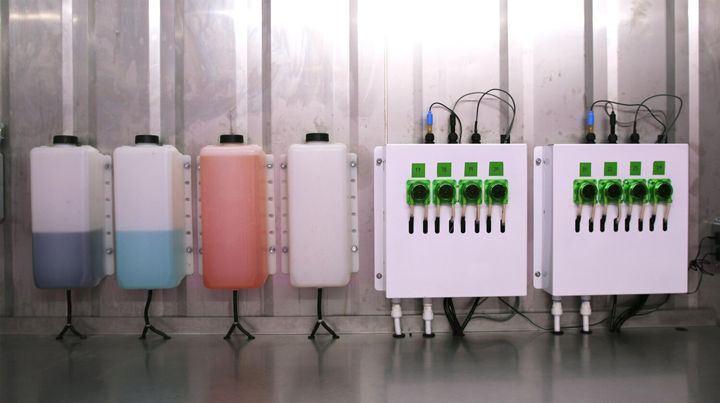There are a lot of factors involved in giving plants the ideal combination of nitrogen, phosphorus, potassium, and other necessary nutrients. The good news is that getting it right in the Greenery is actually pretty easy!
![Nutrients 101: Growing Strong Hydroponic Plants]() Nutrients 101: Growing Strong Hydroponic Plants
Nutrients 101: Growing Strong Hydroponic Plants

Rebecca Shamritsky | Freight Farms
Let’s Talk Nutrients!
Sounds complicated, right? Well, we won’t lie, there are a lot of factors involved in giving plants the ideal combination of nitrogen, phosphorus, potassium, and other necessary nutrients. The good news is that getting it right in the Greenery is actually pretty easy!
Plant Nutrition Basics
Let’s start at the beginning. Plants need nutrients in order to thrive and, in turn, the nutrients these plants absorb make them beneficial for us to eat. The six key nutrients are:
-
Nitrogen (in the form of nitrate): helps foliage grow strong and gives plants their green color by helping with chlorophyll production.
-
Phosphorus: helps with root and flower growth, while helping plants withstand environmental stressors.
-
Potassium: strengthens plants, especially during early growth, and helps them retain water.
-
Magnesium: plays a key role in giving plants their green color.
-
Sulfur: helps plants resist disease and to grow seeds. It also helps the plant create amino acids, enzymes, and vitamins.
-
Calcium: aids in the growth and development of cell walls, which is key for the plant’s ability to prevent disease. It is also essential for the plant to absorb nitrate.
Source: Holganix
When growing plants in a traditional manner, plants absorb these nutrients from the soil. Based on the farming technique, gardeners and farmers will supplement with fertilizers, which can be synthetic (man-made and usually derived from petroleum: Ammonium Nitrate, Ammonium Phosphate, Superphosphate, Potassium Sulfate) or organic (derived from plant and animals: compost, manure, seaweed, worm castings).

Hydroponic Nutrients in the Greenery
With hydroponics, things work a little differently. Without soil, the plants need to get their nutrient supply from somewhere else. Hydroponic systems like the Greenery use water as a nutrient delivery system. Water soluble liquid nutrients are diluted into water that travels to plants’ roots.
When it comes to hydroponic systems, there are different nutrient mixtures based on what you’re trying to grow. Nutrient mixtures are created with three stages in mind: leaf, flower, and fruit. Since we grow leafy greens, lettuces, and herbs in the Greenery, we use solutions formulated specifically for leaf stage growth.
The nutrient mixtures that we use in the Greenery–and the ones we recommend to our farmers– are Fertamax Grow A & B, produced by CleanGrow. However, there are other options for you to choose from, such as Root Organics, GH FloraNova®, Botanicare®, and more! You can see the full list of our recommended nutrients on farmhand®Shop.
You may be asking, why two solutions? That’s because the nutrients need to be separated to prevent them from turning into solids in the tanks (through various chemical reactions). However, once the nutrients are mixed into the water, they become diluted enough that they can mix without any issues.
Another important factor for nutrient dosing in hydroponic systems is the pH level of the water. Most tap and well water has a pH level that is too high for optimal nutrient absorption. We add a pH regulator (General Hydroponics pH Down) to the water in addition to the nutrients to make sure that the water’s pH stays at the right level.
Easy Regulation
Now you know how we supply our plants in the Freight Farms container farm with the proper nutrients! But how do we regulate the nutrients effectively? With traditional farming, farmers can test the pH of their soil easily, but often need to get the nutrients in their soil tested elsewhere, so they only get a read on the soil’s nutrient levels once a season. Comparatively, the Greenery is outfitted with sensors that are constantly monitoring pH and EC levels (EC stands for electro-conductivity, and is the method to measure the nutrient saturation of the water). Automatic dosing panels make sure the levels are always optimal, and the sensors communicate all their data to farmhand®, which creates easy-to-read graphs.
The overall results, are plants that have consistent nutrient supplies. With nutrients so essential for the plants’ survival, it’s very helpful to have a predictable system. This is big factor in Freight Farmers seeing 98% of the produce coming out of the Greenery go to market.
The content & opinions in this article are the author’s and do not necessarily represent the views of AgriTechTomorrow
Comments (0)
This post does not have any comments. Be the first to leave a comment below.
Featured Product

